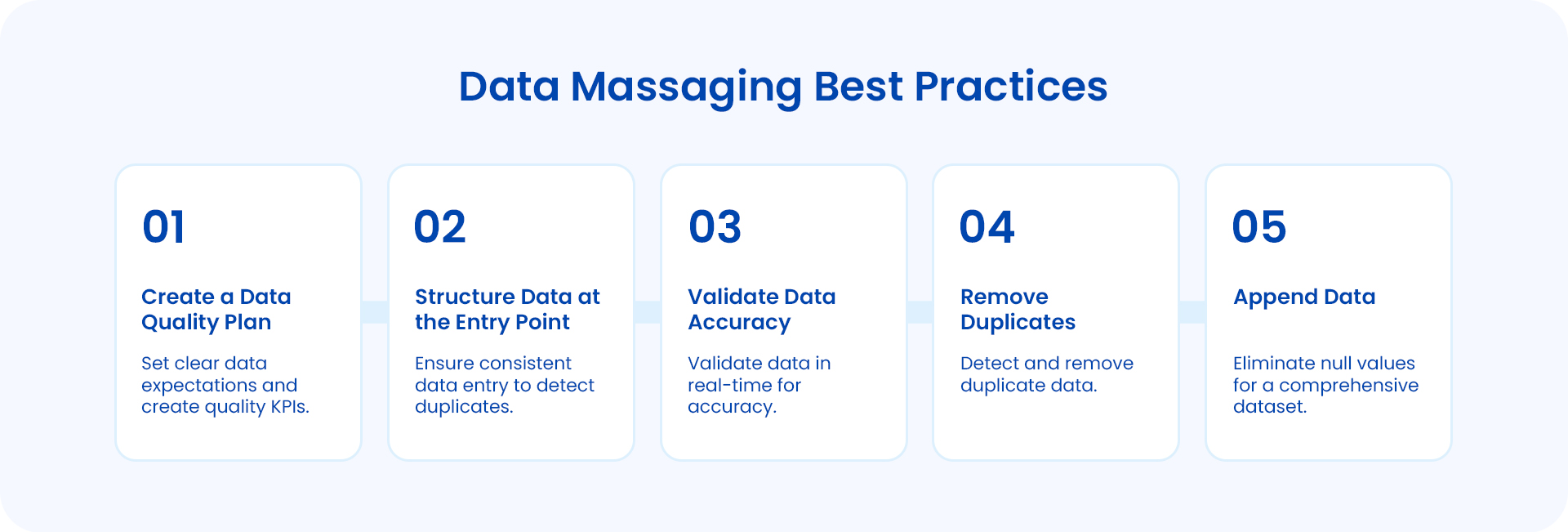
Data Massaging: Benefits and Best Practices
Suppose your supervisor asks you to access your company’s database and lookup for a specific piece of information about a certain product or customer. While it does look like a straightforward task, it can be challenging to accurately locate that info if the database is not formatted the way you anticipated. Even worse, your database may include redundant fields and corrupt data.
So, what do you do now?
That’s where data massaging enters the scene.
What exactly is data massaging? And, how do you massage data?
In this blog, we’ll dive into the process of data massaging, and cover some of its key benefits and best practices.

Source: Enago
What is Data Massaging?
Data massaging, also known as data cleansing or data scrubbing process, is a way to eliminate unnecessary information from data or cleans a dataset to make it useable. It involves processing data to change data formats, remove unwanted characters, duplicates, whitespaces, and more. Simply put, data massaging is the ‘transformation‘ step in the ETL process.
Applying Massaging Techniques on Data
Some common data massaging techniques that convert data into useable form include:
- Changing the format of the source data to make it compatible with the target system (for example, changing date format from dd/mm/yyyy to mm/dd/yyyy).
- Replacing missing values with defaults (for example, entering ‘0’ whenever a quantity is not given).
- Filtering out data that is not desired in the destination system.
- Checking the validity of data and fixing records that can generate errors (for instance, removing special characters like * ^ & that make data invalid).
- Standardizing data to get rid of variations (for example, replacing upper case with lower case or replacing ’01’ with ‘1’).
Why Is It Important to Massage Data?
According to IBM, 80% of a data scientist’s time is spent in preparing, cleaning, and organizing data, leaving only 20% time to analyze it.
This is because enterprises usually generate a huge volume of data from different sources, which can have imperfections due to redundancies or inconsistencies. To make this data usable for analysis, it has to be cleaned, formatted, and standardized; otherwise, the results will be skewed.
This is where data massaging comes into play.
By transforming, cleaning, normalizing, and integrating data, you can ensure the accuracy of data and subsequently, your decision-making.
Data Massaging Best Practices
Follow these best practices to ensure the success of this process:
1. Create a Data Quality Plan
The first step is to set clear expectations for your data and to create data quality KPIs based on specific business rules. Also, consider how you are going to track those KPIs. This will help you maintain data hygiene on an ongoing basis.
It’s important to know where most data quality faults occur so that you can clearly identify any erroneous data. Effective data quality management will help you identify and resolve those errors.
2. Structure Data at the Entry Point
Before data massaging, it is important to check critical data at the point of entry. This guarantees that all data is consistent when it enters your data repository, making it easier for you to detect duplicates.
Create a standard operating procedure (SOP), so that your team only propagates structured data into your database.
3. Validate Data Accuracy
Use data massaging tools that validate the accuracy of your data in real-time. These tools can help you seamlessly massage various datasets without compromising on accuracy.
4. Remove Duplicates
Duplicate data in your repository corrupts results as well as increases maintenance cost. Moreover, it prevents you from having an accurate, single view of data. So, when massaging your data, it is important to detect and remove data replications.
5. Append Data
Sometimes, you may have null values or incomplete records in your source data. To make your dataset comprehensive, it’s important to eliminate these null values or white spaces. Complete data expedites business intelligence and analytics.
So, when massaging your data, it’s important to append data to make your dataset as complete as possible.
By implementing the best practices discussed above, you can identify irrelevant data and by extension ensure successful implementation of your data processes.

Conclusion
The most important step of data massaging is to recognize the sources of unclean data in your repository. This will help you avoid incorrect or duplicate data from piling up.
When it comes to automating data massaging, Astera Centerprise can be your ultimate solution. It’s an end-to-end data integration software that allows you to massage data using built-in transformations, without any coding. You can leverage its process orchestration capabilities to sequence integration and transformation jobs, and execute multiple tasks in parallel.
Download the free trial of Astera Centerprise and experience the software first-hand.



